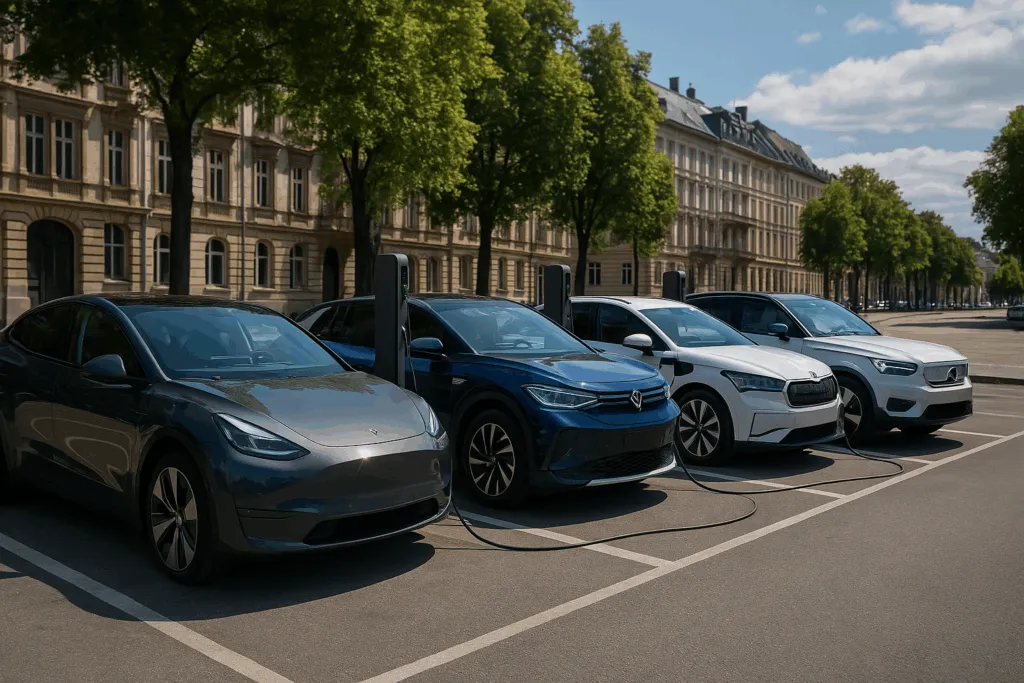В 2025 году Европа стоит на пороге транспортной революции. Электромобили больше не являются нишевым решением; в некоторых странах они стали основным выбором покупателей. Однако темпы перехода к экологичному транспорту на континенте неоднородны, что отражает уникальные экономические, инфраструктурные и политические особенности каждого региона.
Наиболее ярким примером является Норвегия, где 96,9% новых автомобилей, зарегистрированных в 2025 году, будут полностью электрическими. Это результат многолетней целенаправленной политики: от щедрых налоговых льгот до масштабной зарядной инфраструктуры и запрета на продажу автомобилей с двигателями внутреннего сгорания к концу года. Далее следуют Швеция и Нидерланды с показателями около 58% и 55% соответственно. В этих странах спрос стимулируется как заботой об окружающей среде, так и высокими налогами на традиционные автомобили.
Германия и Франция, крупнейшие европейские автопроизводители, демонстрируют умеренные, но устойчивые темпы роста: 42,3% и 38,5% соответственно. Несмотря на сокращение субсидий, немецкий рынок растет благодаря локальному производству электромобилей, а Франция сохраняет активную программу поддержки.
Великобритания и Дания приблизились к отметке 35%, активно реформируя транспортное законодательство. В странах Южной Европы, таких как Италия и Испания, проникновение электромобилей более скромное — 20–22%. Причины варьируются от ограничений инфраструктуры до умеренного потребительского интереса, хотя тенденция остается положительной.
В Восточной Европе электромобили пока занимают незначительную долю рынка: в Польше, Чехии, Венгрии и Румынии их доля колеблется от 8% до 13%. Однако благодаря растущему спросу на бюджетные модели и китайские бренды, а также поддержке ЕС, перспективы региона выглядят многообещающими.
В этом контексте Россия занимает особое положение: здесь на электромобили приходится чуть более 1% новых продаж, а на весь электропарк — около 3–4%. Несмотря на скромные показатели, рост за три года составляет 150%. Государство постепенно наращивает меры поддержки, хотя ключевыми ограничениями остаются инфраструктура и доступность цен.
Общий вектор ясен: Европа уверенно движется к сокращению выбросов в транспортном секторе. Развитие технологий, доступность зарядной инфраструктуры и экологические инициативы делают электромобили не просто альтернативой, а новой нормой. И хотя путь у каждого свой, конечная точка одна: мобильность будущего будет электрической.
В 2025 году Европа стоит на пороге транспортной революции. Электромобили больше не являются нишевым решением; в некоторых странах они стали основным выбором покупателей. Однако темпы перехода к экологичному транспорту на континенте неоднородны, что отражает уникальные экономические, инфраструктурные и политические особенности каждого региона.
Наиболее ярким примером является Норвегия, где 96,9% новых автомобилей, зарегистрированных в 2025 году, будут полностью электрическими. Это результат многолетней целенаправленной политики: от щедрых налоговых льгот до масштабной зарядной инфраструктуры и запрета на продажу автомобилей с двигателями внутреннего сгорания к концу года. Далее следуют Швеция и Нидерланды с показателями около 58% и 55% соответственно. В этих странах спрос стимулируется как заботой об окружающей среде, так и высокими налогами на традиционные автомобили.
Германия и Франция, крупнейшие европейские автопроизводители, демонстрируют умеренные, но устойчивые темпы роста: 42,3% и 38,5% соответственно. Несмотря на сокращение субсидий, немецкий рынок растет благодаря локальному производству электромобилей, а Франция сохраняет активную программу поддержки.
Великобритания и Дания приблизились к отметке 35%, активно реформируя транспортное законодательство. В странах Южной Европы, таких как Италия и Испания, проникновение электромобилей более скромное — 20–22%. Причины варьируются от ограничений инфраструктуры до умеренного потребительского интереса, хотя тенденция остается положительной.
В Восточной Европе электромобили пока занимают незначительную долю рынка: в Польше, Чехии, Венгрии и Румынии их доля колеблется от 8% до 13%. Однако благодаря растущему спросу на бюджетные модели и китайские бренды, а также поддержке ЕС, перспективы региона выглядят многообещающими.
В этом контексте Россия занимает особое положение: здесь на электромобили приходится чуть более 1% новых продаж, а на весь электропарк — около 3–4%. Несмотря на скромные показатели, рост за три года составляет 150%. Государство постепенно наращивает меры поддержки, хотя ключевыми ограничениями остаются инфраструктура и доступность цен.
Общий вектор ясен: Европа уверенно движется к сокращению выбросов в транспортном секторе. Развитие технологий, доступность зарядной инфраструктуры и экологические инициативы делают электромобили не просто альтернативой, а новой нормой. И хотя путь у каждого свой, конечная точка одна: мобильность будущего будет электрической.











